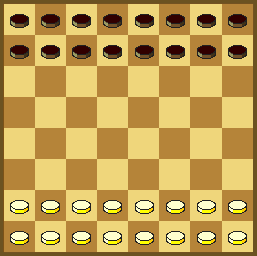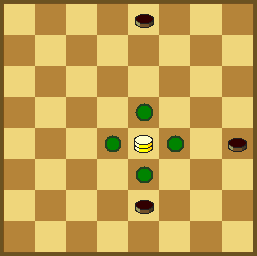

A Man moves diagonally or orthogonally forwards. It captures by withdrawal.
An orthogonally adjacent piece is captured by moving to an
empty square in any orthogonal direction, except backwards.
Capture is mandatory and must continue as long as possible.
During a capture sequence, it may not return from where it came. It is
not necessary to capture the maximal number of pieces. A Man
promotes to King at the last rank. A King can step in all
directions. It captures in the same way as a Man,
except that the enemy piece needn’t be adjacent (“remote
withdrawal capture”). It may also go backwards to capture.
The goal is to capture all enemy pieces or to achieve stalemate.
Two Kings against one is sufficient for a win. In fact, one King
against one is always a win.
A similar withdrawal capture is known from the Madagascan folk
game Fanorona. In traditional Gothic checkers (Altdeutsches Damespiel),
a Man moves diagonally forward, but capture occurs by the short leap.
Examples
 The white Man must capture the black Man by going either north or west (it may not go south).
The white Man must capture the black Man by going either north or west (it may not go south).
 The King can capture all black Men by going west. In any other direction, it captures only two. The Man which is approached will not be captured.
The King can capture all black Men by going west. In any other direction, it captures only two. The Man which is approached will not be captured.
References
Winther, M. (2017). ‘Gothic Checkers Variants’. (here)
‘Fanorona’. Wikipedia article. (here)
• You can download my free Neogothic Checkers program here, (updated 2020-09-22) but you must own the software Zillions of Games to be able to run it (I recommend the download version).
© M. Winther (Sept 2020).